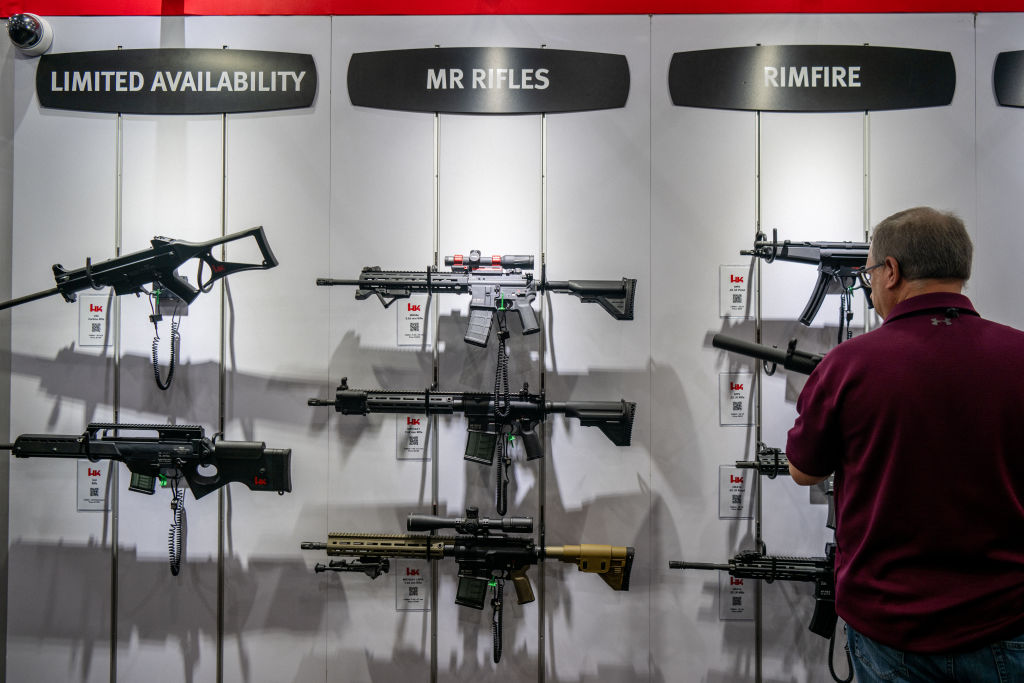Women's Rights & Issues
Related: About this forumMedia Coverage of Uvalde Misses the Gender Issues at the Heart of School Shootings
(lengthy, important read at link)
Media Coverage of Uvalde Misses the Gender Issues at the Heart of School Shootings
6/6/2022 by Jackson Katz
In order to have a productive national debate about gun policy, we need to be willing to talk about the ways in which guns are woven deeply into cultural narratives about American masculinity.

A man views rifles during the National Rifle Association (NRA) convention on May 28, 2022 in Houston, Texas. The annual NRA convention comes days after the mass shooting in Uvalde, Texas which left 19 students and 2 adults dead, with the gunman fatally shot by law enforcement officers. (Photo by Brandon Bell/Getty Images)
Amidst the outpouring of heartache, grief, and outrage about the latest gun massacre of innocent children, this time in the small town of Uvalde, Texas, why are so few voices in mainstream American media talking about the gender issues at the heart of this and so many other similar incidents? What is so hard about saying — out loud — that the overwhelming majority of these killings are done by boys and young men, and then going a little deeper and asking why? Instead, since the spring of 1998, when a string of school shootings riveted the country’s attention and inaugurated this grotesque Era of School Shootings, media coverage of these events — with just a few exceptions — has followed an embarrassingly predictable and superficial script that imposes gender neutrality on a highly gendered phenomenon. It’s remarkable how many gender-neutral terms commentators come up with to describe the perpetrators of these heinous crimes: “shooter,” “18-year-old,” “loner” “killer,” “terrorist,” “student,” “teenager,” “young person,” “armed individual.”
People think it’s so obvious the shooters are young men that there’s literally no point in saying so. In that sense, “gunman” is internally redundant; everyone knows that “man” follows “gun.” The one gendered term people do often use is “gunman,” a word whose very constituent parts — gun/man — offer a clue as to why gender-neutral terms are so popular on this topic. People think it’s so obvious the shooters are young men that there’s literally no point in saying so. In that sense, “gunman” is internally redundant; everyone knows that “man” follows “gun.” One way to think about the near-invisibility of gender in this debate is to consider the word “gunwoman.” The awkward but revealing dictionary definition of this uncommon word is “a female gunman.”
If the Uvalde killer had been an 18-year-old woman, does anyone think the national conversation about her terrible crime would omit mention of the fact that she’s a woman? More likely, it would be the first thing anyone would be talking about. Just as it should be when the murderers are men, which they are in 99 percent of school shootings.

Brad Fowler of San Antonio, Texas, lights up candles at a memorial dedicated to the victims of the mass shooting at Robb Elementary School on June 3, 2022 in Uvalde, Texas. 19 students and two teachers were killed on May 24 after an 18-year-old gunman opened fire inside the school. (Photo by Alex Wong/Getty Images)
But that’s not how it works. Media coverage of school shootings — and many other mass killings — tends to emphasize a range of other causative factors. The main ones are “mental illness” and the easy availability of military-style semi-automatic weapons, facilitated by the successful efforts of gun industry lobbyists and right-wing politicians who continue to block basic gun safety policies. The New York Times did run a front-page article on June 2nd that uncharacteristically discussed some of the reasons why the shooters are almost always male — in a story whose headline and central theme was the age of the shooters. Much more common is the lack of any attempt to analyze gender in commentary about school shootings. This was exemplified starkly in a 2019 op-ed in Education Week, entitled “What School Shooters Have in Common,” and written by James Densley and Jillian Peterson, whose work has circulated widely since Uvalde.
The two academics have developed a remarkable data base of school shootings dating back to 1966. They found that school shooters typically have four things in common: they suffered early childhood trauma, they were angry or despondent over a recent event, sometimes resulting in suicidality, they studied other shootings online, and they possessed the means to carry out the attack. But like most analysts of school shootings, the authors didn’t highlight or examine gender as something almost all the shooters have in common. They did mention it in a subsequent paragraph, in which they suggested — helpfully — that schools can adopt curricula focused on “teaching positive coping skills, resilience, and social-emotional learning, especially to young boys.” Then they buried the most critical data point at the end of the paragraph, in parentheses: ******(“According to our data, 98 percent of mass shooters are men”), and said nothing further about it. ****
. . . . .
https://msmagazine.com/2022/06/06/media-coverage-of-uvalde-misses-the-gender-issues-at-the-heart-of-school-shootings/